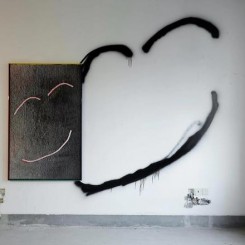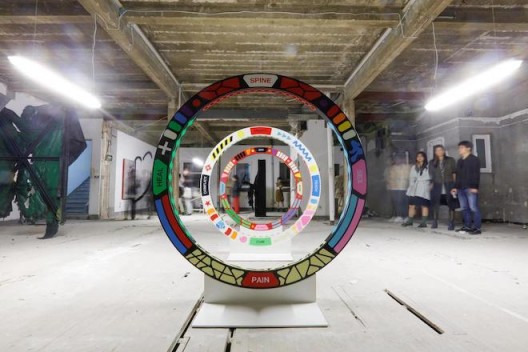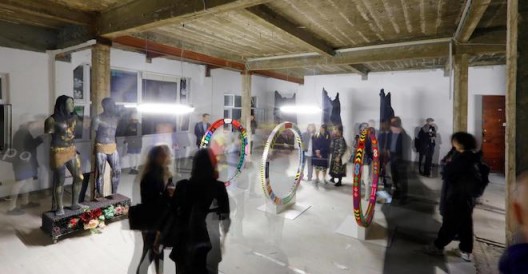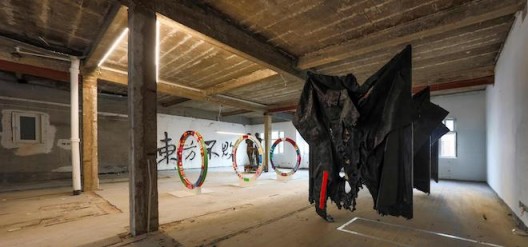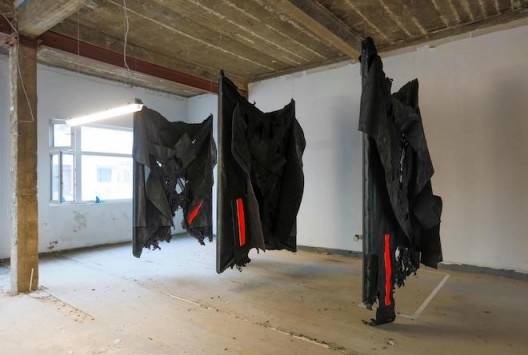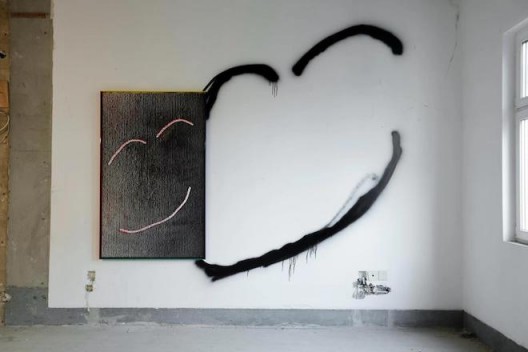Sifang Art Museum, Shanghai Pop-up
by Alice Gee
Sifang Art Museum Shanghai pop-up (Jing’An District) 8 Nov.-8 Dec. 2019
I stand beside three large rings mounted on white platforms at equidistant intervals. Nik Kosmas is talking about 13 years ago and being 20 someplace else. ‘I’m 21!’ I blurt out. I edge back and hope one of Li Jingxiong’s tarpaulins will topple down and engulf me. I ask Nik about his work. ‘It’s all about the body. The throat is a circle that can be grasped in a sexual or violent gesture’. I say something inane about sinews. ‘Sure’. It is the opening of Li Jingxiong X Nik Kosmas, a pop-up show in Shanghai from the Sifang Art Museum, Nanjing. I stomp round a room full of over-sized t-shirts and Feiyue trainers in my ill-judged burgundy heels and lap round Nik’s Rings evading eye contact.
Nik’s work is crammed with signifiers: symbols, patterns, words, short lyrics. ‘INTERPRET ME’. The longer I entertain the request, the more I am stupefied. Take a Keith Haring and incise out geometric shapes (his ‘cut-outs’ would be convenient). Now back those shapes onto magnets and feel the satisfactory tug as they curl into place. Playful. Only the longer you look, the more it’s you that’s being played with.
A Li Jingxiong work stands in the room’s corner: ‘Burned vertical air conditioner, wheel and monitor’. Some remnants of an apocalypse have coalesced into a cuboid two metres high. A wheel juts out from its middle.
Jingxiong lost over 30 works when his studio burnt down in 2016. ‘Burned’ was made from the salvaged remnants. The charcoal colour of the objects was not total enough though, so Jinxiong enhanced the blackness. The result is velvety – a Black-Hole textured with a soft, static buzz. Everything decomposes, the mossy black dictates, and its little life and those of its operators will eventually subsume into nothingness.
I ask Jingxiong if his work is hopeful or hopeless. ‘Hopeless’. The word fits but it doesn’t seem right. Why black? ‘Black is an attitude’. Black is also an expression of constraint.
Produced in a smoggy factory-town, the sculpture internalises the dull, mechanical repetitions of its environment and collapses its lifecycle into theatre. The austerity of the sculpture forces the viewer to still herself and meditate upon functionless, futureless products. It seems a definitive attitude against the daily assault of luminous HD images selling shiny products to shiny people. ‘People think things only get better, but this is not the only possibility’. The sculpture warns of a bleak future. Or, it is a reminder that destruction is the only certainty. Less soberly, the sculpture also says that the virtual, colourful possibilities we aspire to are illusory distractions from life’s dull, ordinary grind. A hopeless future is not certain, but it is best avoided if you confront its possibility.
‘What about these?’ In front of the doorway, and in symmetry with Nik’s three rings, hangs what looks like three, giant, Rorschach inkblots. The edges flay out and the centre is punctuated with singed holes. Bats? Vulvas? A fluorescent red strip peaks from beneath tarpaulin folds. ‘Steel pipe, military canvas, waterproof canvas, fireproof canvas and rubber sheets’. What happens when you set something fire-proof on fire? ‘I wanted to shock people. Burning is not normal’. Racing up three flights of stairs in a residential block to greet enveloping, alien spectres is jarring.
I ask Jingxiong about how his works relate to Nik’s. Beginnings and endings. Life cycles. Jingxiong works quickly, his production line takes off where the commercial factory line ends. The factories take raw materials and makes functional products, Jingxiong takes functional products, destroys them, and uses the remnants as raw materials for his projects. We sketch diagrams in my notebook and talk about the ability of art to visualise life’s invisible interconnected patterns.
I am emboldened. I return to Nik’s work. This time, I talk to Nik’s friends. One man engages with the work like it’s a video game with three levels and no instructions. Twist and turn the rings, press the buttons and try to level up. This piece has emerged from a 5-year hiatus from art, a dark period. The work marks the beginning of a creative period unlike Nik’s previous projects. ‘I want to say hopeful, but that’s not quite right’. The work isn’t hopeful, it’s colourful and frustrating: it is full of possibility.
Kosmas writes sci-fi stories. The rings prompt me to Philip K Dick: ‘If reality differs from person to person, can we speak of reality singular, or shouldn’t we really be talking about plural realities?’ The empty space between the three rings is like a fourth dimension. One woman describes it as a ‘dream spot’, several people envision carnivals of animals leaping through its rings: but there is a shared urge to jump through it, like Alice through the rabbit hole. A rabbit-hole of Dick’s plural realities. How will you play the game? Where will it take you?
For a brief moment, I hold Lu Xun’s attention. In reaction to an over-polished Shanghai, Xun designed the Pop-Up space to mimic the unpolished art spaces of Berlin. He wanted to ‘strip the room of pretension’ (I wonder what the builders he paid to destroy the aspirational, residential apartment would think of his statement). The stripped, industrial feel compliments Jingxiong’s works, as if they are relics of a dystopian wasteland. Nik lives in ‘un-polished’ Berlin.
At the back of the room, drip down four Chinese characters. ‘East is not lost’ a man translates. ‘Hope’, he says, for local artists like himself, who feel pushed out by the westernisation of Shanghai’s art scene. ‘China Never Dies’ Jingxiong tells me. The plastic mural singes down the wall. Does it crumble away or resist destruction? Does death annihilate or does something remain, caught in the spatial, timeless space at the centre of life’s circle? These are the works of young artists in an un-finished room. Hope for the best, expect the worst: anything is possible. Take the wheel and play the game.
Sifang Art Museum, Nanjing
www.sifangartmuseum.org
China, 珍 Pukou, 7th Rd, 9号CN 江苏省 南京市 邮政编码: 210000

